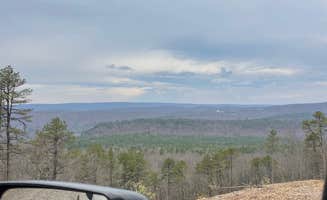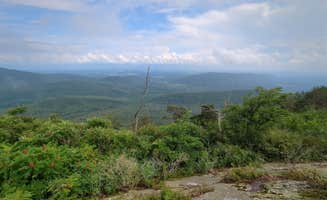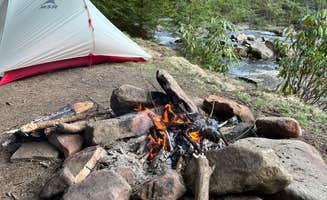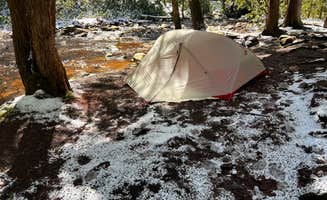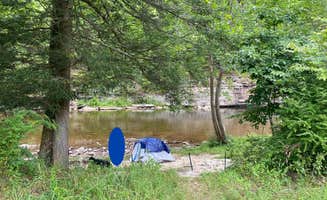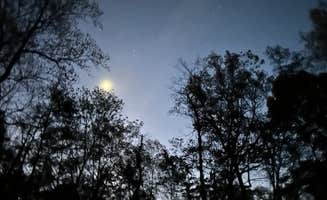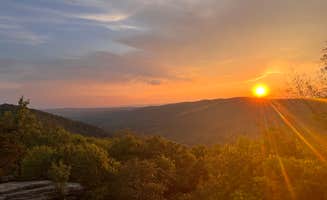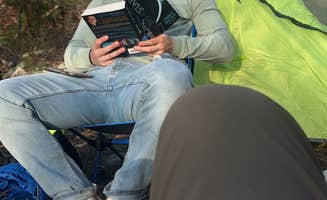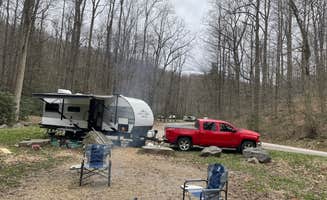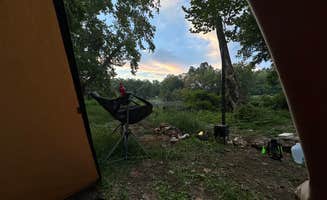Dispersed camping near Burlington, West Virginia offers primitive sites nestled within the Monongahela National Forest at elevations ranging from 2,500 to 4,000 feet. Winter temperatures frequently drop below freezing at higher elevations, with road closures common after snowfall. The forest terrain varies significantly, with areas transitioning from hardwood forests to pine stands depending on elevation.
What to do
Hike to Blackwater Falls: From Canaan Loop Road Dispersed campsites, access trails that connect to Blackwater Falls State Park. A camper notes, "There are some that are about 4 mile hike to blackwater falls state park. And it's an easy drive to Seneca rocks."
Winter camping adventures: For experienced cold-weather campers, winter offers unique opportunities. As one camper at Canaan Loop Road shared, "It snowed but we didn't die 🤣. We camped here on a winter road trip fully prepared for the worst weather and this mountain top dispersed site delivered."
Fishing access: Lower Glady Dispersed Campground provides direct access to fishing spots. One visitor mentioned, "Nice camp sites, and good fishing," while another noted the helpfulness of locals: "A few friendly fishermen each day, sharing local knowledge."
Creek exploration: Several campsites sit adjacent to water features. At Little Fort Campground, a reviewer noted, "Nice trails/creek behind site," providing opportunities for wading and nature observation during warmer months.
What campers like
Privacy between sites: The Squirrel Hollow Road Camping area offers secluded spots away from crowds. A camper reported, "Sites are located less than a mile from the paved highway. We found 5 spots just off the road. Sites were quiet at night. Some traffic related to logging activity."
Pine forest camping: Several sites feature distinctive pine stands that create carpet-like ground cover. At Squirrel Gap Rd Dispersed, one camper noted, "Quite a few miles down Squirrel Gap Rd. There is another sunnier sight a little before this one. But this one is right off the road, entrance is steep. Decent sized area, stone fire ring, plenty of firewood."
Riverside settings: Some dispersed camping options near Burlington provide waterfront access. A visitor to South Fork Shenandoah River shared, "The site at the end of the road is beautiful. We stayed right at the end of the road, since we have a 30 foot RV, but there are sites you can walk to all the way down the river."
Well-maintained vault toilets: Campers appreciate the facilities at Lower Glady Dispersed Campground, with one reviewer stating, "The toilet was one of the cleanest I have seen. Most sites have good shade while still open to the sky."
What you should know
Weather preparedness essential: Conditions can change rapidly at higher elevations. At Wolf Gap Recreation Area, defined campsites provide structure but remain exposed to weather systems. A visitor described, "The campsite itself is beautifully wooded. Each campsite is mostly secluded from the rest of the park."
Road conditions vary significantly: Forest Service roads range from well-maintained to challenging. One camper at Brushy Ridge Road Dispersed noted, "Brushy Ridge Road is Forest Service Road 75 and is in decent condition. There are several pull off campsites along this road on the way up to Dolly Sods wilderness."
Cell service limitations: Most dispersed camping areas near Burlington have minimal or no connectivity. A Little Fort Campground camper warned, "On this app it says T-Mobile access, I'm a T-Mobile customer, no reception at all but drive 5 minutes back down the mountain and you're good to go."
Spring conditions: Early season camping often means encountering snow or mud. A Canaan Loop Road camper shared, "Still snow on the ground and very wet in early April, but great dispersed car camp and walk-in camp sites."
Tips for camping with families
Choose established sites: For family camping near Burlington, Little Fort Campground offers structured sites with amenities. A visitor described, "Great established free campground! Site had a fire pit, table, parking spot, and tent platform. Bathrooms and bear proof trash was provided."
Consider Edwards Run for introductory fishing: This area provides accessible fishing opportunities for beginners. One camper noted, "Fun place to teach the kids the basics of fishing, but the campground area leaves a little to be desired."
Weekend planning crucial: Popular sites fill quickly during peak times. A Lower Glady camper warned, "We tried to get a spot this weekend and arrived around 430pm on Friday. Every single spot was taken with many people who look like they have been set up there all summer."
Pack for temperature swings: High-elevation camping means preparing for variable conditions. A Canaan Loop Road visitor advised, "Don't come here in the winter unless you are prepared for any kind of weather event. It's very secluded and you need to definitely be self sufficient."
Tips from RVers
RV accessibility varies by site: While most dispersed camping near Burlington accommodates small trailers, larger rigs face limitations. One Lower Glady camper shared, "We pulled our 28 foot travel trailer in past I'd say ten other campsites that were taken. The last big turnaround featured four rv accessible campfires for us to pick."
Consider campsite leveling: Many forest road pull-offs require careful positioning. A visitor to Wolf Gap Recreation Area observed, "Many of the car parking pads are not level. But the tent pads appear to be."
Road navigation planning: Access to dispersed sites often involves narrow roads with tight turns. A camper at Canaan Loop Road advised, "Road is easy to drive on - some bumps but we were in a small kia sedan and it was fine, there are a lot of spots visible from the road."


